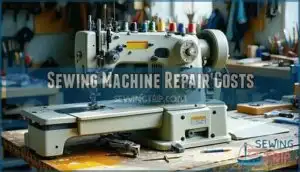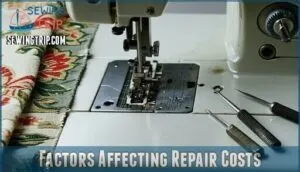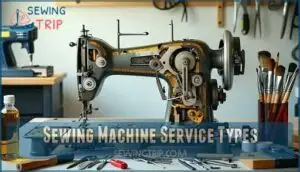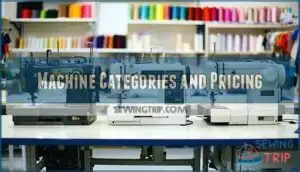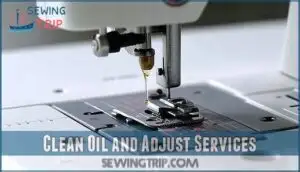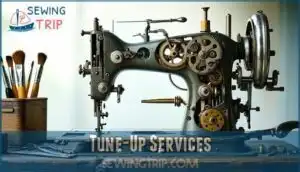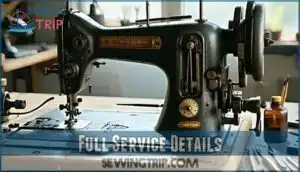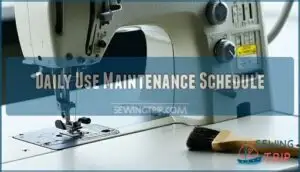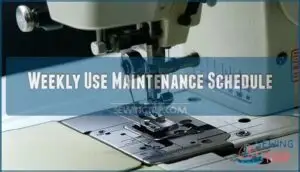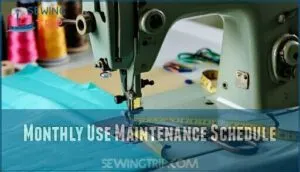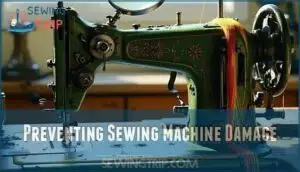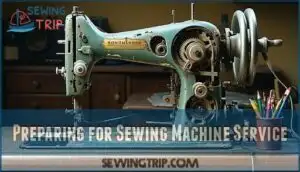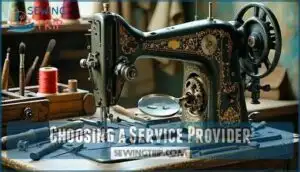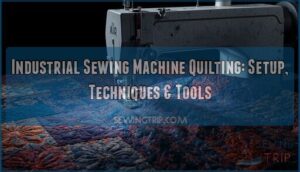This site is supported by our readers. We may earn a commission, at no cost to you, if you purchase through links.
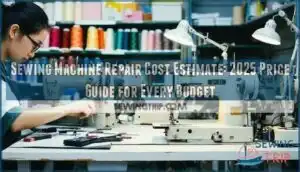 Sewing machine repair costs vary between $50 and $300, depending on factors like your machine’s type, the issue’s complexity, and the repair shop.
Sewing machine repair costs vary between $50 and $300, depending on factors like your machine’s type, the issue’s complexity, and the repair shop.
A standard tune-up, including cleaning and adjustments, typically costs around $75 to $100. If you’ve got a computerized or industrial machine, repairs can lean toward the higher end.
Small fixes, like tension adjustments, might cost less, while replacing parts (gears, motors) can push the price up. It’s a bit like maintaining a car; regular servicing keeps costs down.
Need specifics? Brands, shop rates, and service types matter—there’s more to explore when breaking down the numbers.
Table Of Contents
- Key Takeaways
- Sewing Machine Repair Costs
- Factors Affecting Repair Costs
- Sewing Machine Service Types
- Machine Categories and Pricing
- Common Sewing Machine Services
- Maintenance and Care Frequency
- Preventing Sewing Machine Damage
- Preparing for Sewing Machine Service
- Choosing a Service Provider
- Frequently Asked Questions (FAQs)
- Conclusion
Key Takeaways
- You’ll spend an average of $75-$100 for standard sewing machine repairs, but prices rise with machine type and issue complexity.
- Regular tune-ups cost $75-$140 and prevent bigger problems, saving you more in the long run.
- Industrial and computerized machine repairs are more expensive due to specialized parts and labor, often costing $140 or more.
- Choose trusted technicians with clear reviews and pricing, and always ask about warranties and potential discounts.
Sewing Machine Repair Costs
You’ll find most sewing machine repairs cost between $75 and $100, with prices varying based on your machine type and the complexity of the issue.
Mechanical machines typically run around $75 to fix, while computerized models or vintage machines often cost $100 or more due to their specialized parts and technical requirements, which can make them more expensive to repair, especially if they have complexity.
Mechanical repairs cost $75, while vintage or computerized machines exceed $100 due to specialized parts and technical intricacies.
Average Repair Cost Factors
When estimating your sewing machine repair cost, several factors come into play.
The complexity of the issue typically impacts labor rates, with diagnostic fees ranging from $50-75.
Part scarcity for older models can substantially increase costs.
Your machine’s warranty status may reduce expenses, while specialized technician expertise commands premium pricing.
Cost breakdown usually includes evaluation, parts, and labor—averaging $75-$100 for standard repairs in 2025.
Regular tune-ups can help prevent extensive repair needs.
Machine Type Repair Costs
The cost of repairing your sewing machine varies substantially by type.
Mechanical machines typically cost around $75 to fix, while computerized models average $100.
Long-arm machines run about $80 for repairs, and vintage machines often exceed $100 due to rare parts.
Embroidery machines start at $100, and industrial machines have the highest repair costs, ranging from $60 to $150 per hour, with costs that can be quite substantial.
Complexity of Issue Repair Costs
The complexity of your sewing machine issue substantially impacts repair costs.
Simpler problems cost less than intricate ones requiring specialized expertise.
When estimating repair costs, consider:
- Issue severity – minor timing adjustments ($50) vs. major electrical problems ($100+)
- Diagnostic costs – typically $20-30 before actual repairs
- Part scarcity – vintage or discontinued components can triple repair estimates
Labor complexity and repair time also factor into your final sewing machine repair cost.
Factors Affecting Repair Costs
You’ll find that several key elements impact what you’ll pay for sewing machine repairs, including your machine’s brand, complexity, and whether it contains custom components.
The repair shop you choose also matters, with specialized technicians typically charging more than general repair services.
Machine Brand Repair Costs
Your machine’s brand substantially impacts repair costs in 2025.
High-end brands like Bernina and Janome typically cost 15-25% more to repair due to specialized parts and technician expertise.
Vintage brand repairs for Singer or Pfaff models average $100+ because of rare components.
Meanwhile, common brand issues with Brother or Singer machines usually have more affordable repair estimates, ranging from $75-$125, making cost factors more predictable for budget planning.
Custom Components Repair Costs
Some sewing machines rely on proprietary parts or rare components, which can hike your repair costs.
If a part is difficult to source, expect a higher sewing machine repair cost estimate due to labor and shipping.
Customization impacts pricing too—unique features may require specialized work.
Always confirm parts replacement fees with clear cost estimates before committing to repairs.
Shop Type Repair Costs
Dealer vs. independent sewing machine repair shops can substantially impact costs.
Authorized repair centers often charge more, while local quilt shops or vacuum store repairs may save you money.
Online repair services offer convenience but include shipping fees.
Comparing service pricing at your local repair shop helps you get the best sewing machine repair cost estimate for your budget.
Sewing Machine Service Types
You’ve got several service options to keep your sewing machine running smoothly, from basic cleaning to full repairs.
Understanding the types of maintenance available helps you plan for both routine care and unexpected fixes, which is crucial for the smoothly operation of your machine.
Clean and Service Rates
When considering clean and service options, sewing machine service costs vary based on Service Pricing Factors like Machine Complexity and Service Interval.
Expect $110 for domestic mechanicals, $140 for computerized machines, and $170 for embroidery models.
Regular preventative maintenance can save you money in the long run, especially if you pair professional services with DIY cleaning to reduce repair estimates.
Specialized Service Rates
How much does specialized service cost? Rates vary based on needs, like an Embroidery Unit at $55 or Walking Foot service at $55.
Adjust Serger Tensions for $45 or consider a Head Frame or Carrier Service at $239.95.
Sewing machine repair prices also depend on the hourly rate, with service prices commonly between $75 to $250 for repairs.
On-Site Service Rates
On-site convenience can be a lifesaver when your sewing machine breaks unexpectedly.
Emergency repairs are quick but often add travel fees.
Common services include:
- Repairs and tune-ups at home
- Home setup and training included
- Sewing machine repair costs starting at $50/hour
- Transparent sewing machine repair prices upfront
An on-site sewing machine repair estimate guarantees no surprises and provides transparent sewing machine repair prices upfront.
Machine Categories and Pricing
You’ll find that repair costs vary depending on whether your machine is mechanical, computerized, or industrial.
Each category comes with its own price range, so knowing what type you have can help you plan ahead, considering the complete concepts of costs and machine types.
Domestic Mechanical Machine Pricing
In the case of mechanical sewing machines, repair pricing typically starts at $75 but can climb depending on vintage machine costs or repair complexity impact.
Preventative maintenance prices around $110 offer long-term value by tackling issues early, making service costs manageable for domestic machines.
A sewing machine repair cost estimate guarantees clarity, and basic service cost covers cleaning and adjustments.
Domestic Computerized Machine Pricing
A computerized sewing machine often costs $140 for service, reflecting its advanced features.
Repair pricing depends on tasks like sensor calibration or software updates.
Here’s a breakdown:
- Feature complexity: $140+
- Display screens: $140-$170
- Software updates: $150+
- Motor types: $140-$160
- Sensor calibration: $170+
This specialized service cost guarantees top performance.
Industrial Machine Pricing
Industrial machines often carry higher repair costs due to their size and intensity.
Heavy-duty costs can range from $399.99 to $500 annually, influenced by factory machine rates and usage frequency.
Specialized industrial services, like bulk order pricing for repairs, justify higher sewing machine service quotes.
Always explore leasing vs. buying options and request a sewing machine repair cost estimate for accurate service pricing.
Common Sewing Machine Services
In regards to sewing machine care, common services like cleaning, oiling, and adjustments are essential to keep your machine running smoothly.
These services prevent costly repairs as well as extend the overall lifespan of your equipment.
Clean Oil and Adjust Services
Cleaning, oiling, and adjusting your sewing machine regularly ensures flawless performance, extends its life, and prevents costly repairs.
Cleaning, oiling, and adjusting (COA) your sewing machine keeps it running smoothly while preventing costly repairs.
COA benefits include improved stitching and extended lifespan. Professionals use specific cleaning solvents for lint removal, proper lubrication types for moving parts, and precise tension adjustment.
Using the correct sewing machine lubricant is vital for peak performance. A preventative COA, often included in your sewing machine service estimate, guarantees lasting performance and reliability after each service.
Tune-Up Services
If your machine’s been cleaned but still isn’t sewing smoothly, a tune-up might be your next step.
Regular tune-ups, done annually for frequent use, keep your sewing precision sharp.
Whether you tackle a DIY tune-up or consult a pro for a full tune-up checklist, these sessions address tensions, timing, and lubrication.
A professional tune-up often costs $75-$100.
Full Service Details
If you’re looking for a thorough tune-up beyond basic fixes, full service is your best bet.
It includes tasks like disassembly, lubrication, tension checks, and precise calibration.
A detailed service checklist guarantees nothing’s overlooked.
Repair inclusions vary, and specialized prices may apply.
Always request a diagnostic assessment upfront to clarify sewing machine repair cost estimates and plan for machine service costs.
Maintenance and Care Frequency
Keeping your sewing machine on a regular maintenance schedule helps it run smoothly and last longer.
Whether you use your machine daily, weekly, or monthly, timely care can save you from costly repairs down the line.
Daily Use Maintenance Schedule
To keep your sewing machine running smoothly with daily use, stick to these basics:
- Lint Removal: Wipe away lint buildup after every session.
- Oiling Frequency: Lubricate moving parts as listed in your manual.
- Needle Inspection: Check for wear or damage each day.
A quick daily routine guarantees smoother stitching and extends your machine’s life.
Regular use of a specialized lint brush can help with this task.
Weekly Use Maintenance Schedule
If you use your sewing machine weekly, aim for a yearly sewing machine maintenance schedule.
Regularly focus on lint removal, oiling points, and bobbin cleaning to prevent build-up. Don’t skip needle inspection—it guarantees smooth stitching and reduces wear.
Stitch testing after maintenance confirms everything’s in top shape.
Regular application of specialized machine lubricant keeps parts moving smoothly.
Routine sewing machine lubrication adds years to your machine’s life while guaranteeing consistent performance.
Monthly Use Maintenance Schedule
If you sew monthly, schedule machine maintenance every two years.
Regular sewing machine cleaning prevents lint buildup, while sewing machine lubrication keeps parts running smoothly.
Check tension and clean the bobbin to maintain stitch quality.
To guarantee superior performance, follow a detailed maintenance checklist.
Stick to this preventative maintenance routine, and your machine will thank you with trouble-free sewing.
A clear sewing machine maintenance schedule saves time and avoids costly repairs.
Preventing Sewing Machine Damage
You can avoid costly sewing machine repairs by taking simple steps to prevent damage.
Regular cleaning, using suitable fabrics, and following the manual’s instructions will keep your machine running smoothly.
Daily Cleaning Importance
A stitch in time saves your machine.
Daily sewing machine cleaning, using proper tools, prevents lint buildup and fabric residue from clogging parts.
Regular lint removal, needle care, and timely oiling frequency act as preventative measures, enhancing performance.
Simple DIY maintenance, like cleaning dust off with a soft brush, protects delicate mechanisms, ensuring your machine’s stitches stay flawless.
Suitable Fabric Usage
Picking the right fabric matters.
Heavy fabrics strain your machine, while delicate ones demand gentler tension adjustments.
Match thread type and needle size to the fabric for smoother stitching.
Ignoring these can lead to costly repairs, as sewing machine technicians often attribute issues to mismatched components.
A simple stitch settings guide can save you from unnecessary sewing machine repair costs down the line.
Selecting the right material involves understanding fabric weight considerations to prevent machine strain and ensure proper maintenance.
Following Manual Instructions
Understanding your sewing machine manual isn’t just about proper usage—it’s a preventative measure against costly repairs or warranty voidance.
Follow the troubleshooting guide for simple fixes and avoid DIY repairs not covered by the manual.
- Review manual updates to stay informed.
- Prevent misuse by adhering to guidelines.
- Save on repairs by addressing minor issues yourself using the sewing machine troubleshooting section.
Preparing for Sewing Machine Service
Before heading for a sewing machine service, make sure you gather all the essential components like the power cord, foot pedal, and standard accessories.
Regular at-home cleaning can also help keep lint buildup in check, especially if you work with soft fabrics, and this can be considered a key part of regular maintenance.
Required Components for Service
Bring your power cord, foot pedal, zig-zag foot, and the correct bobbin when scheduling sewing machine repair or maintenance services.
Don’t forget the machine manual—it’s a lifesaver for technicians.
Missing parts can increase the overall sewing machine repair cost estimate.
Organized preparation guarantees smooth servicing and prevents delays, saving you time and preserving your machine’s functionality.
At-Home Cleaning Benefits
Keeping your sewing machine clean at home saves money and extends its life.
Regularly removing lint buildup and fabric residue prevents tension issues and needle damage.
Proper oiling frequency keeps parts running smoothly, reducing the need for frequent sewing machine repair.
With basic sewing machine cleaning tools, you’ll handle upkeep between professional sewing machine cleaning services, ensuring better overall sewing machine care and maintaining your machine’s longevity through regular maintenance.
Soft Fabric Cleaning Requirements
Soft fabrics like minky require extra care to prevent lint buildup and thread residue.
Regular cleaning frequency depends on the fabric type you’re using, but minky cleaning should be more frequent.
Use sewing machine cleaning tools to remove debris and follow up with proper machine cleaning and sewing machine oil. This simple step helps avoid higher sewing machine repair cost estimates later.
Choosing a Service Provider
You’ll want to choose a service provider who’s reliable, knowledgeable, and experienced with sewing machines.
Focus on turnaround time and ask about discounts to guarantee you get quality service within your budget.
Preferable Shop Types
Your sewing machine deserves care from the best hands.
Prefer repair shops with on-site technicians or nearby vacuum stores offering skilled service. Local quilting shops often handle detailed fixes too.
For brand-specific needs, an authorized sewing machine service center is ideal.
- Top choices include:
- Local repair shops with expertise
- Sewing machine repair centers
- Trusted sewing and vacuum retailers
Turnaround Time Importance
Understanding your repair turnaround time is a must.
Service urgency impacts project deadlines and customer expectations, especially if downtime derails plans.
Clear repair communication with your provider guarantees minimal delays.
A shop’s efficiency often balances sewing machine repair cost estimates with reliable delivery.
Quick service reduces downtime, keeping your machine humming and your productivity on track, which is crucial for maintaining project timelines and meeting customer expectations.
Discount Inquiries
Ask service providers about seasonal discounts or membership benefits—they often shave a bit off sewing machine repair costs.
Some shops offer bulk discounts if you’re servicing multiple machines or referral programs to reduce repair cost estimates.
Keep an eye out for deals similar to Cricut’s Black Friday offers, as sewing machine services might also have promotions during similar times.
Don’t shy away from negotiating prices; knowing typical sewing machine service pricing gives you leverage, and it’s always worth exploring ways to save.
Frequently Asked Questions (FAQs)
What is the average cost to repair a sewing machine?
Picture your sewing machine as a trusted dance partner.
Repair costs can twirl between $75 and $100 on average, depending on the repair’s complexity and machine type.
Vintage or computerized machines might tip higher.
How much should a sewing machine service cost?
A typical sewing machine service costs $110 to $250, depending on the type and complexity of your machine.
Mechanical models sit at the lower end, while embroidery or industrial machines require higher costs due to specialized care.
Is it worth it to fix a sewing machine?
Fixing a sewing machine is worth it if the repair cost is less than buying a new one, especially for high-quality or vintage machines.
Regular servicing also keeps your machine running smoothly for years.
How much does it cost to restore an old sewing machine?
Restoring an old sewing machine feels like breathing new life into a classic tune.
Costs range from $100 to $250, more for rare models.
Prices depend on repairs, parts, and the technician’s expertise.
How do I identify a trusted technician?
Look for a technician with good reviews, clear communication, and upfront pricing.
Ask about certifications, experience with your machine type, and turnaround time.
Local shops often offer personalized service, which builds trust quickly.
What warranties cover sewing machine repairs?
Warranties for sewing machine repairs vary.
Some shops offer 30 to 90 days on parts and labor, covering defects or faulty repairs.
Always ask upfront about warranty terms to guarantee peace of mind after repairs.
Are mobile repair services more expensive?
Mobile repair services are often pricier due to convenience, travel costs, and the added flexibility they offer.
While they save you time and effort, expect rates to include extra charges compared to in-shop repairs, which can be a significant consideration for convenience.
Can I request emergency repair services?
Fixing a machine in distress is like reviving an old friend.
Yes, emergency sewing machine repairs are usually available, but they often cost extra.
Call local shops to confirm availability and pricing, especially for emergency services.
What indicators suggest a machine needs repair?
Your sewing machine might need repair if it skips stitches, makes unusual noises, struggles to feed fabric, or sews unevenly.
Frequent thread breaks or tension trouble are also clear signs something’s off, with frequent being an indicator of a persistent issue.
Conclusion
Did you know a sewing machine tune-up can cost as little as $75 but save you hundreds in future repairs?
Understanding your sewing machine repair cost estimate helps you budget wisely and extend your machine’s life.
From routine cleanings to complex part replacements, regular maintenance makes all the difference.
Whether you’re fixing a mechanical model or servicing a computerized one, knowing the costs and options guarantees better decisions—and a smoother sewing experience every time.

